Top News
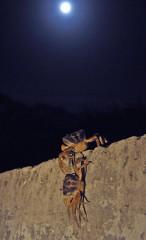
June 17, 2011 Ryukyu Shimpo
A species of terrestrial crab known as okagani (biological name: Discoplax hirtipes) were observed spawning on the night on June 15 on Ikemajima, which is located to the north of Miyako Island.
The crabs moved from the Ikema wetland to the seashore and spawned on the edge of the water. They held their eggs on their bellies as they moved down towards the sea in the moonlight.
Every year around the time of full moon on May 15 in the old lunar calendar they are usually observed spawning on Ikemajima, which has close distance between the wetland and the seashore. This year, the crabs started to move across the road on the island on June 15.
Some travel agencies went as far as arranging coach tours to watch the crabs spawn. So many people gathered that some of the crabs almost seemed to be afraid of the human presence and hesitated to go down to the edge of the water.
The crabs managed to get to the sea to shake their bodies in tune with the movement of the waves, spawning their progeny, which are about to hatch.
Seven year-old Keigo Taira and Ryushin Nakama, both in their first year at Hirara First Elementary School, watched the crabs spawn, saying, “It was the first time for us to see crabs spawn like this. It was really interesting.”
(English Translation by T&CT, Mark Ealey)
Go To Japanese
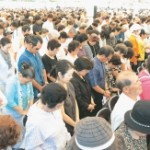
June 23, 2011 Ryukyu Shimpo
On Thursday, June 23, Okinawa marked the 66th anniversary of the end of the Battle of Okinawa in which more than 200,000 people lost their lives.
At the Peace Memorial Park in Mabuni, Itoman City, Okinawa Prefecture and the prefectural assembly held a ceremony for the victims of the Battle of Okinawa and issued a pledge for world peace.
There are growing voices of protest within the prefecture against the decision by the governments of the United States and Japan at the US-Japan Security Consultative Committee for defense ministers and foreign ministers (2+2) held on June 21, to go ahead and build a V-shape runway at Henoko, Nago City, as a replacement facility for the U.S. Marine Corps Futenma Air Station.
The prefecture marked the 66th anniversary of the end of the battle amidst ongoing problems related to the U.S. military bases in Okinawa.
The mass commemorative march for peace arrived at the Peace Memorial Park at 11:30am, marking the 50th anniversary of it being held. About 5,000 visitors prayed for the victims at 12:00pm and accepted the pledge for peace.
At the ceremony, Yoshinao Nakasone, the head of the Okinawa Association of War Bereaved Families said, “The Japanese government once promised relocation of the facilities at Futenma Air Station out of the prefecture and out of the country, however, Japanese Prime Minster Naoto Kan now clearly states that the government will adhere to the agreement reached by the U.S. and Japanese governments for relocating the facilities at Futenma Air Station to Henoko. The Okinawan people have unambiguously expressed their views through the resolution of the prefectural assembly and through protest rallies. The people of Okinawa will not tolerate any activity that may lead to war.”
The Governor of Okinawa Prefecture Hirokazu Nakaima read out a peace declaration after Prime Minister Kan made his appearance at the ceremony and the representative of students had offered a floral tribute.
Tomoka Kamida, a second-year student at Nakanishi Junior High School in Urasoe City, read out a poem for peace entitled, “One scene from the happy days,” which she wrote for her grandmother, who was a teacher during the Battle of Okinawa, and for her grandmother’s students.
(English Translation by T&CT, Mark Ealey)
Translated from an article on PDF document below:
http://ryukyushimpo.jp/uploads/img4e02b50719432.pdf
Go To Japanese

U.S.-Japan 2+2 decides on a V-shaped runway at Henoko and the withdrawal from the timeline for relocation of the Futenma
June 22, 2011 reports of Washington DC, by Hideki Matsudo of Ryukyu Shimpo
The U.S.-Japan Security Consultative Committee meeting of defence ministers and foreign ministers (2+2) was held in Washington on June 21. With regard to the relocation plan for the United States Marine Corps Futenma Air Station, a pending issue between both governments, they backed down on the deadline of 2014 to complete it and reconfirmed that it will “be completed as soon as possible.”
Both governments agreed to go ahead with the building of a V-shaped runway 1800 meters long at Henoko-zaki in Nago City. They suggest that there could be minor adjustments to allow environmental impact assessments to be made regarding building the runway offshore without any significant delay in the schedule or obstructions to the construction.
Both governments also shared their views on the establishment of a regional hub for disaster relief. It is speculated that the candidate locations will be somewhere in the Ryukyu Islands, including Shimoji-jima. They expect this to deepen the nature of the US-Japan alliance by incorporating the center within its international contribution.
The meeting was attended by Secretary of State Hillary Rodham Clinton, Secretary of Defense Robert M. Gates, Minister for Foreign Affairs Takeaki Matsumoto, and Minister of Defense Toshimi Kitazawa. At the press conference after the committee meeting, Gates said that they “emphasized the importance of concrete progress over the course of the next year.” Kitazawa said, “We will make every effort to gain the understanding of the local people.”
Go To Japanese
“Incomprehensible!” Governor of Okinawa expresses strong discomfort towards the proposed V-shaped runway at Henoko
June 22, 2011 Ryukyu Shimpo
Okinawa Prefectural Governor Hirokazu Nakaima voiced his strong discomfort that at the US-Japan Security Consultative Committee (2+2), the governments of Japan and the United States have decided to go ahead with building a V-shaped runway at Henoko, Nago City as a replacement facility of the United Stares Marine Corps Futenma Air Station. He said, “It’s incomprehensible. What are they doing trying to implement something that’s just not possible?” and continued, “On repeated occasions, I have told both governments that this is an absurd way of doing things. However many decisions they may make on this, how are they going to do it?”
Go To Japanese
“2+2” – a black mark on history that undermines democracy
June 22, 2011 Ryukyu Shimpo
On June 21, in Washington, for the first time in four years, the governments of Japan and the United States held the U.S.-Japan Security Consultative Committee (2+2) at which they reconfirmed that they are to push ahead with the plan for the relocation of U.S. Marine Corps Futenma Air Station to Henoko, Nago City. They have decided to use a landfill approach and build a V-shaped alternative facility with two runways on area offshore.
There is no way that we can accept this. It is against the will of the Okinawan people who have called for the facilities and functions now at Futenma to be moved outside the prefecture. Both governments deliberately ignore the will of the people of Okinawa.
Despite the political situation within Okinawa on the Futenma relocation issue and the perception within the United States Congress having greatly changed, the content of the agreement seems to have slipped backwards to match that of four years ago.
It is the first time for a U.S.-Japan Security Consultative Committee meeting to be held since the Democratic Party came to power, but they have clearly disregarded the wishes of the Okinawan people in making the decision to push ahead with the relocation to Henoko. This is a far cry from democracy – indeed it is an abuse of power by both governments.
To us, the joint statement issued with the subtitle: “Toward a Deeper and Broader U.S.-Japan Alliance: Building on 50 Years of Partnership” rings hollow like a work of fiction. The agreement [on the Futenma relocation issue] not only runs contrary to the idea of reducing the burden placed on the people of Okinawa by military bases, and as such serves to degrade the U.S.-Japan alliance, but the way it undermines the basic tenets of democracy will also likely see it remembered as a black mark in history.
Go To Japanese
(English Translation by T&CT, Mark Ealey)

June 17, 2011 Ryukyu Shimpo
The Memorial Ceremony to Commemorate the Fallen on the Anniversary of the Battle of Okinawa will be held at Mabuni, Itoman City, on June 23. At the ceremony, Tomoka Kamida, 13 year-old student of the second grade of Nakanishi Junior High School in Urasoe City will read her poem entitled “One scene from the happy days.”
She said, “I want the strength of our will to get through, both to the bereaved and to the survivors of the war, letting them know that we will strive to protect peace,” on June 16, ahead of the ceremony.
Her grandmother who was born during the Taisho era (1912-1926) showed her a photograph, and that moved her to write the poem. In the picture, her grandmother, a schoolteacher back in those days, was surrounded by 20 or 30 smiling school children. Her grandmother told her sadly that, “Had it not been for the war, so many more people would have been happy.”
Tomoka sensed that the suffering from the horrors of war was hidden behind the children’s smiles, “War is useless. My grandma told me about how much pain it causes,” she said.
Despite 66 years having passed since the war, many U.S. bases still remain in Okinawa. When Tomoka walked alongside a fence of a base recently she thought, “The war has long since ended. Why should we still have such huge U.S. military bases here?” Hearing news reports that Osprey aircraft will be deployed to the U.S. Marine Corps Air Station Futenma and constantly bothered by the noise of military aircraft, she is reminded that, “Wars are still happening somewhere in the world.”
In Okinawa, we have many opportunities to consider matters of peace and war, but “We should not stop at just thinking about it; we should step forward now to act,” she said, insisting that it is important to learn from the scars of war. A photograph of someone smiling at having overcome painful experiences, “Will be a ‘truly happy photograph’ when there are no more wars,” she said gazing into the distance.
(English Translation by T&CT, Mark Ealey)
Go To Japanese
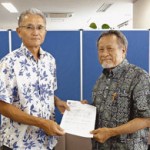
June 17, 2011 Ryukyu Shimpo
During the 15-year period since 1987, Shinichi Maehara, the executive director of Okinawa Television Broadcasting Co., Ltd. (OTV), has interviewed many Uchinanchu active around the world, introducing them in a documentary entitled Sekai-Uchinanchu-Kiko (Global travel stories to meet Uchinanchu).
The University of Hawaii has decided to award him an honorary doctorate in humanities in recognition of his achievement. Robert Nakasone, senior advisor for the Center for Okinawan Studies of the University visited Okinawa to convey the good news to him, but the degree will actually be conferred at the 2011 Mid-Year Commencement Ceremony of University of Hawaii at Manoa, on December 17.
According to the University, an honorary doctoral degree is awarded to people who have contributed in the fields of the humanities or to Hawaii.
In the past, several distinguished Japanese such as Nobel laureates including novelist Yasunari Kawabata and others have been awarded the degree. Recommended for the award by the University of Hawaii at Manoa, Maehara is first person from Okinawa to receive this honor.
A total of 210 editions of his documentary program have been shown in Hawaii since 2003 and have steadily gained popularity. Nakasone praised Maehara’s achievement, saying, “His work is very highly thought of in Hawaii.”
Maehara said, “Immigrants from Okinawa have been paving their way in life together, despite discrimination against them in Hawaii. They have created a very well-formed community there,” and “I think it is usually awarded to researchers, and so it is an undeserved honor for me,” he said with delight.
(English Translation by T&CT, Mark Ealey)
Go To Japanese

June 16, 2011 The Ryukyu Shimpo
An Ako tree (Ficus superba Miq. var. japonica Miq.) estimated to be over 300 years-old that stood in the Katsuren-Hama district of Uruma City has been blown over by the strong winds of Typhoon No.2. It was laid bare as it smashed down on the masonry block wall of Hama Junior High School. Local residents believe that a Kijimuna, or Okinawan fairy, lives in the old tree. They love the tree and want to preserve it.
Ninety-four year-old Fumio Asato, a former head of the district, said that although the tree survived the Battle of Okinawa, it began to rot after the war. However, its seeds dropped down into the rotting trunk, somehow giving it new life.
“A Kijimuna fairy lives there in the cavity of the tree. We have heard stories that the fairy sometimes comes out and creeps into the mosquito nets above beds in the houses,” said 84 year-old Isamu Hamajo. At school athletic meetings, locals enjoyed the children’s efforts from up in the old tree and some people rested in the shade that it offered. Hamajo said, “We feel really close to this tree.”
It is now roped off and the broken parts of the block wall have been removed. “We will somehow preserve the tree by transplanting it or using some other method. It means a lot to us,” said the head of Katsuren-Hama Yoshiteru Shinzato as he awaits a decision from the municipal office.
(English Translation by T&CT, Mark Ealey)
Go To Japanese
June 15, 2011 Takashi Hokama of Ryukyu Shimpo
Okinawa prefecture is promoting the construction of a testing center for Android, a software stack for mobile devices that includes an operating system, middleware and key applications. To date, Google Inc. has led the way in the development of the Android mobile operating system. Okinawa is looking to establish a discussion group before the end of June to focus on building the testing center.
In cooperation with YRP (Yokosuka Research Park) Research & Development Promotion Committee (Kanagawa Prefecture), an international research center for many types of wired or wireless communications systems, the prefecture plans to research the possibility of developing application software on Android.
Okinawa prefecture has reached an agreement with Akio Motai, the head of YRP, with regard to various proposals to be put to the discussion group and training.
Companies in Okinawa that develop application software on Android have will also be represented. The prefecture plans to let the private sector run the center and is considering locating it in the Okinawa IT Shinryo Park in Uruma City.
The discussion group plans to organize a range of activities in an effort to get the center up and running.
YRP head Motai said, “Research into wireless communication systems is progressing. Developing application software on Android matches the needs of the times. That is why we would like to set up this group and give it our full support so it becomes one of the best research institutes in the world.” Motai continued, “Okinawan companies are doing really well in the area of information and communication technology, and I think that they have considerable ongoing potential. It is quite feasible that they will play a key role in Asia.”
Motai went on to point out the need for the prefecture to work on the expansion of job opportunities, saying, “Human resource development is needed.”
YRP hosts independent laboratories of companies such as Nippon Telegraph and Telephone Corporation, which is commonly known as NTT, as well as NTT Docomo Inc. and Panasonic Mobile Communications Co., Ltd., and Fujitsu Limited. Research institutes of about 60 organizations from all over the world concentrate on YRP, which embraces more than 6000 researchers.
YRP has facilities suitable for implementing a range of experiments and the verification of research and development for wireless communications systems.
The head office of YRP said, “We are keen to cooperate with Okinawa in providing technical know-how on communications experiments.”
(English Translation by T&CT, Mark Ealey)
Go To Japanese
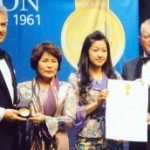
June 17, 2011 Ryukyu Shimpo
The Sweet Bakery Porsche Co., (president Kazuko Takushi) located in Yomitan Village, won two gold medals for its products, Beni-imo-tart and Shiogoma-chinsukou, and one bronze medal for its Beni-imo-galette in the food section of the 2011 Monde Selection. The tart has received the honor of winning the gold medal for four consecutive years and the chinsukou’s gold medal is the fifth in a row. The awards ceremony was held in Brussels, Belgium.
Company president Kazuko Takushi said, “We are delighted that our flagship products have been able to win awards in consecutive years. We want to make products that our customers are always satisfied with.”
(English Translation by T&CT, Mark Ealey)
Go To Japanese
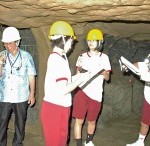
June 15, 2011 Ryukyu Shimpo
Twenty-four Haebaru Junior High School third-grade students have qualified as peace guides for battlefield tours of Okinawa.
As practice, on June 21 they are scheduled to guide first grade boys and girls from their own school through the Haebaru Imperial Japanese Army Hospital Cave. The previous week, on June 14, they rehearsed their guide-commentary in the No. 20 Cave, which is open to the public.
According to a staff member of the Haebaru Cultural Center, training for junior high school students as guides is a rare initiative within the prefecture.
The peace tour study for boys and girls of this age is the brainchild of 38 year-old social studies teacher Takashi Miyara who wanted his students to know about the ravages of war in their own area. The Peace Guides Group and the Culture Center also cooperated in the initiative. From May 10 this year the students have spent time learning about the lead-up to the Battle of Okinawa in six sessions of two lessons each, and have taken part in a study tour around notable battle sites in the town.
In order to become qualified to guide visitors around the battle sites they need to have these lessons, to attend a workshop of the Center and to register with the Haebaru Peace Guides Group. Miyara recommends his students to do this as the first step in a general study program, hoping that the boys and girls will grow up aware of the ravages of war through their experience telling people about the Battle of Okinawa.
The students practiced their commentary in No. 20 Cave, explaining the situation during the war, pointing at wooden posts burned by blasts from the flamethrowers used by U.S. soldiers, indicating the surgery area where wounded soldiers’ limbs were amputated without anesthesia and the rest area for the girls of the Himeyuri Student Corps. Masakatsu Fujiwara, the local head of the Peace Guides Group and museum attendant Katsuya Uechi taught them where a guide should stand and how to use appropriate intonation in their voice.
Fifteen year-old student Reimi Taira said, “I thought it was scary in the cave, but my fear disappeared when I thought that during the war young women the same as me had taken care of wounded soldiers. I want to tell people from Okinawa and further afield about the damage to Haebaru Town during the war.”
(English Translation by T&CT, Mark Ealey)
Go To Japanese

June 14, 2011, Ryukyu Shimpo
On June 11, the “Thousand Crane Project For a Hopeful Future,” which reutilizes paper cranes donated by peace memorial facilities and battle sites in Okinawa, held its fifth delivery ceremony at Okinawa Prefectural Peace Memorial Museum in Mabuni, Itoman City.
The museum handed over approximately one million paper cranes to the “Thousand Crane Project For a Hopeful Future,” a non-profit-organization based in Hiroshima City. Those paper cranes will be converted into stationery, such as notebooks, and sent to the children in conflict-torn regions such as Afghanistan.
About 200 people including children and their parents, students and people with disabilities took part in the delivery ceremony and worked on selecting recyclable paper cranes.
The day of the ceremony marked exactly three months having passed since the Great East Japan Earthquake. At 2:46pm, the exact time that it occurred, those participating in the ceremony offered silent prayers for the victims of the earthquake and tsunami.
Reiko Goya, the chief curator of the museum said, “We would like to deliver the thoughts embodied in these paper cranes to the children of the conflict-torn regions. We would like not just to pray for peace, but also to create peace.” Mayumi Shigematsu, the head of “Thousand Crane Project For a Hopeful Future,” said, “We need to do more than praying for peace.”
Twelve year-old Shuhei Kubota and 13 year-old Rai Takeshima, both in their first year at Miwa Junior High School and taking part in the ceremony for the first time, said, “We wish for a world without any wars in which everyone is equal.”
(English Translation by T&CT, Mark Ealey)
Go To Japanese
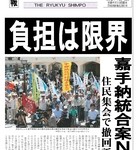
June 12, 2011 Ryukyu Shimpo
“Protest rally against the Kadena-Futenma integration plan” was held at Michinoeki Kadena, in Kadena Town. Those at the rally adopted a resolution and called for the rescinding of the Kadena-Futenma integration plan, the reduction of accidents related to the U.S. military bases in Okinawa and relocation of Futenma Air Station either out of the prefecture or out of Japan.
Suffering from the negative impact of noise and exhaust fumes from U.S. airplanes, local citizens issued a firm “NO” to the re-emergence of any plan that looks to integrate the Futenma U.S. Marine Air Station into the Kadena Air Base.
The anti-integration executive committee consists of members from the Kadena Town Assembly, the Kadena Council for Countermeasures for the U.S. military bases and the Council of the Heads of Residents’ Associations. Hiromi Tasaki, the head of the Kadena Town Assembly, chaired the Committee. In addition to the Committee, the representatives of Kadena Town Women’s Association and Kadena Town Senior Citizens’ Club also expressed their stance at the rally.
Before the rally, the Chubu Okinawa Association of Chairmen of Town and Village Assemblies called for the participation of neighboring municipalities.
The rally confirmed that a delegation consisting mainly of town councilors would visit Tokyo and directly pass a resolution to the Japanese government prior to the Two-plus-Two meeting of the U.S.-Japan Security Consultative Committee scheduled for June 21.
Okinawa now sees the Kadena-Futenma integration plan emerge for the third time.
This time, Carl Levin, Chairman of the Senate Armed Services Committee and others senators considered the current plan put forward by both the U.S. and Japanese governments for the relocation of Futenma Air Station to be unrealistic and proposed the Kadena-Futenma integration plan to the Department of Defense as an alternative.
(English Translation by T&CT, Mark Ealey)
Go To Japanese
Go To Extra edition(PDF)










 Webcam(Kokusai Street)
Webcam(Kokusai Street)


